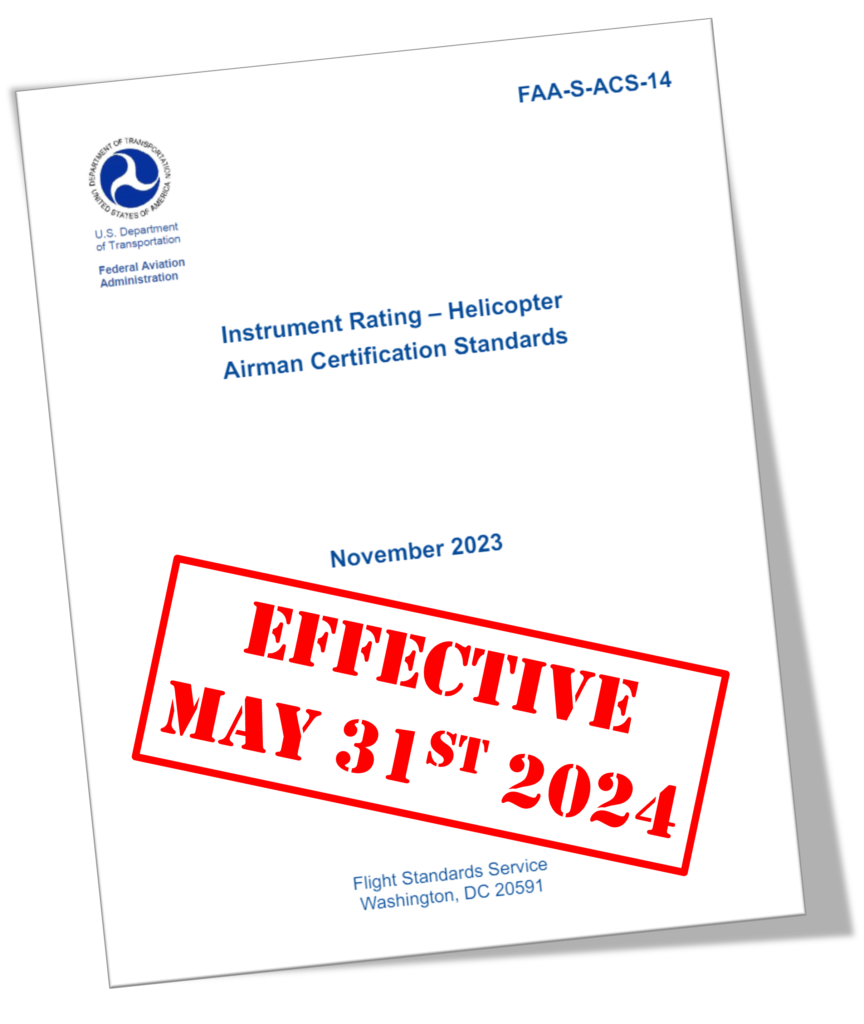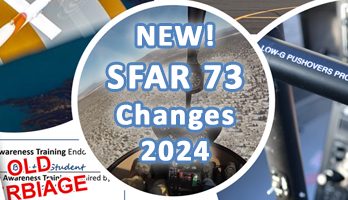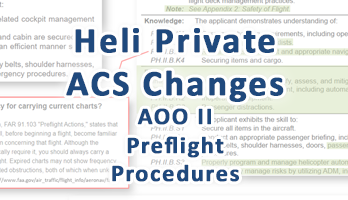Effective May 31st, 2024 the FAA Helicopter Instrument PTS (along with Private, Commercial & CFI) will be replaced by the new FAA Helicopter Instrument ACS (Airman Certification Standards). In this article we will cover the BIG changes from PTS to ACS for the Helicopter Instrument Rating.
General ACS Changes
But first, if the ACS is completely new to you, before reading the specific changes below check out our ACS overview article and ACS overview video covering the new ACS code system, task structure, required elements, changes to special emphasis areas, risk management and more.
Follow Along
If you want to follow along with the changes, grab the free PDF from the FAA’s ACS webpage or purchase the paper version (Amazon affiliate links to help support HTV) below. Paper versions also come with the ACS Companion Guide for Pilots (FAA-G-ACS-2).
Helicopter ACS Instrument – The BIG Changes Video
Approach Types
The old Helicopter Instrument PTS essentially stated that for the checkride you must have an aircraft able to fly two of the following non-precision approaches – VOR, NDB, GPS, LOC, SDF, LDA.
If an LPV approach was selected, it could count as a precision approach if it had a DH at or below 300′ AGL, else it could be counted as a non-precision.
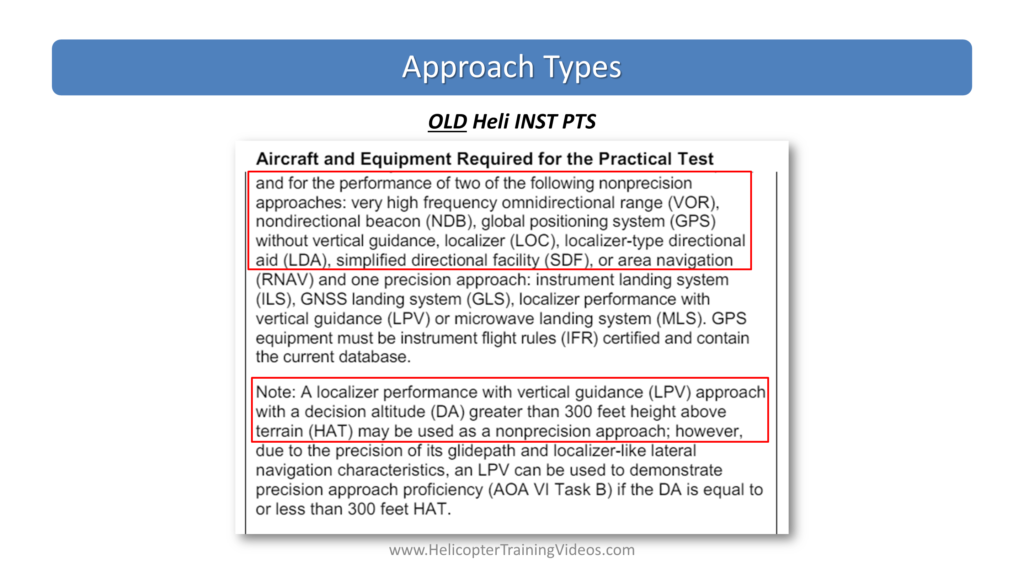
The old PTS non-precision approach (NPA) task went further to say that the two NPAs must utilize two different types of navigation aid. So you could not select two GPS approaches or two VOR approaches.
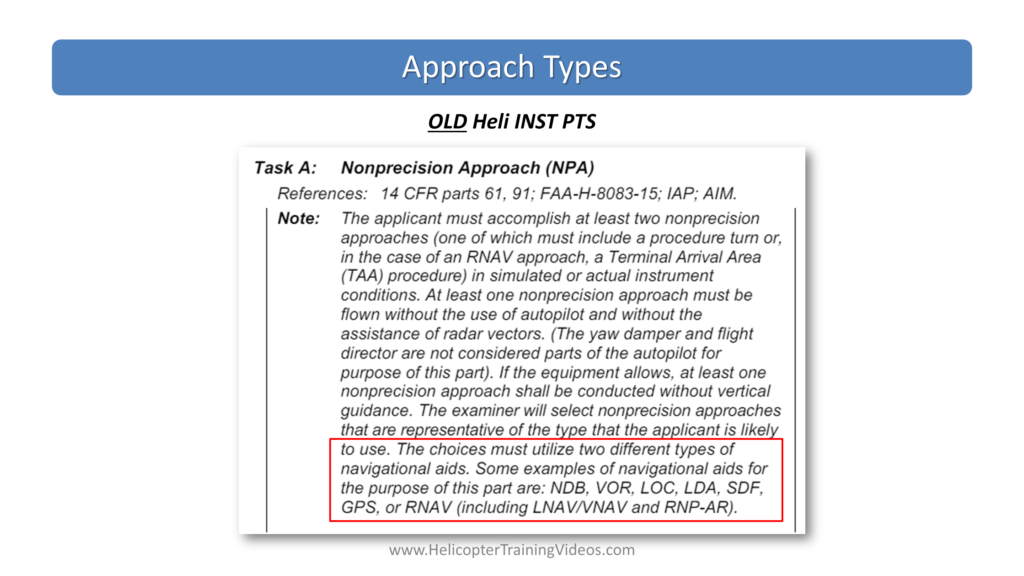
Due to these restrictions typical PTS-based checkride would be:
- One precision approach like an ILS or LPV (<300 DA)
- Two different NPAs types, such as one RNAV (LP or LNAV) and one VOR (or LOC, SDF, LDA or NDB if you can find one)
As the FAA moved away from maintaining lots of ground-based navigation aids (as part of the VOR MON program), it became harder and harder to complete checkrides using that criteria, especially if the one VOR in the area went down for maintenance.
But under the new Instrument ACS (and the updated CFII PTS) there is no language requiring different types of navigation aids. The ACS just states they need to be two different non-precision approaches. Not different types, just not the same approach twice.
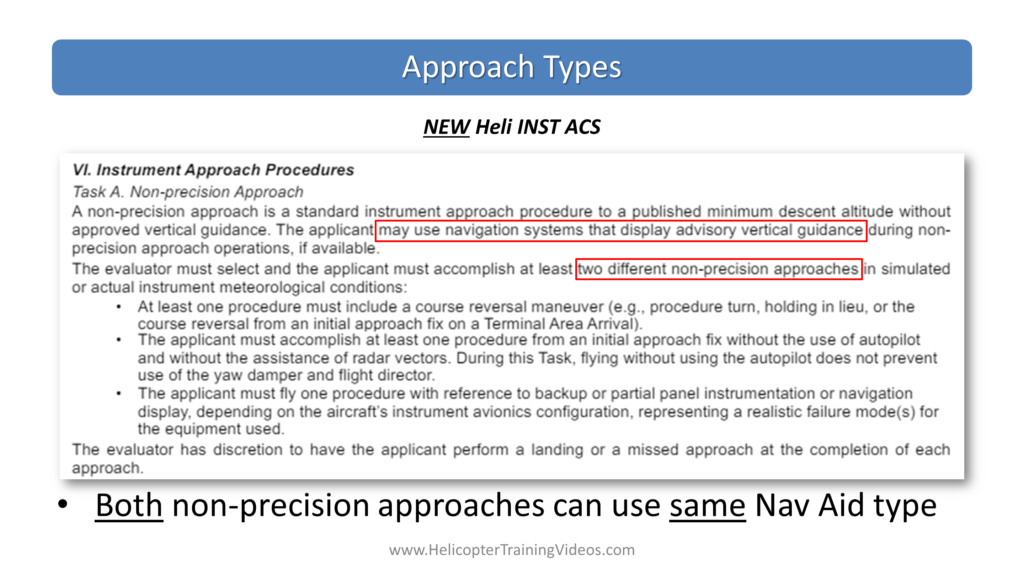
Also says advisory vertical guidance (such as a LNAV+V or LP+V) is also allowed during a non-precision approach. That would also include vertical guidance displayed while flying the non-precision minima of an approach that has both precision and non-precision minima – ILS/LOC, LPV/LNAV etc.
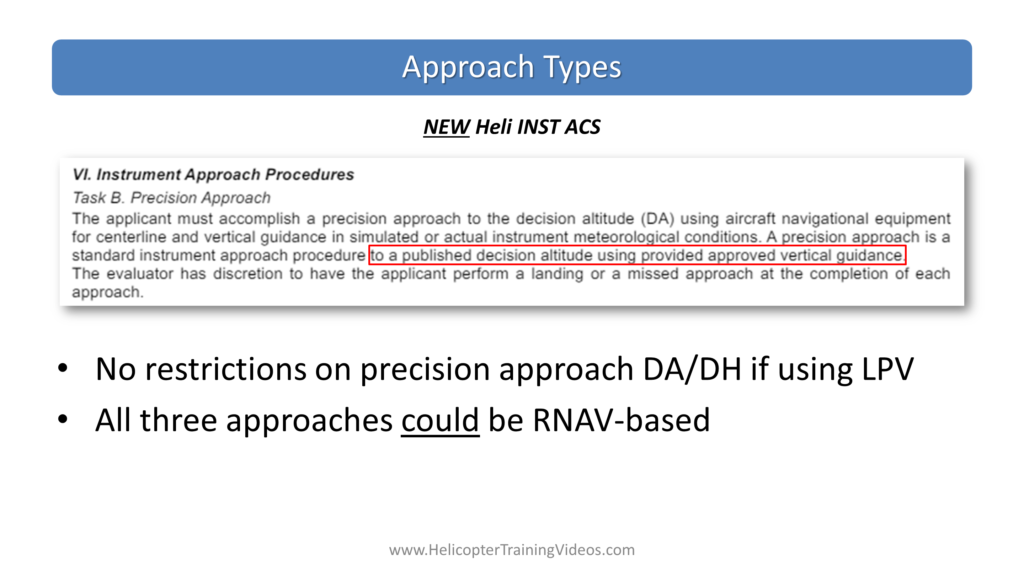
The ACS defines precision approach (for the checkride at least) as any published approach with vertical guidance to a DH (ILS, LPV, LNAV/VNAV and LDA with Glide Slope). Also gone away is any restrictions on an LPV DH. So, although that means any LPV can be used as a precision approach, you can no longer use an LPV as a NPA if it has a DA above 300’ AGL.
So a typical ACS-based instrument checkride could not be all RNAV-based, something like:
- One LPV minima (no restriction on published DH)
- One LNAV/LP/Circling minima
- A different RNAV LNAV/LP/Circling minima
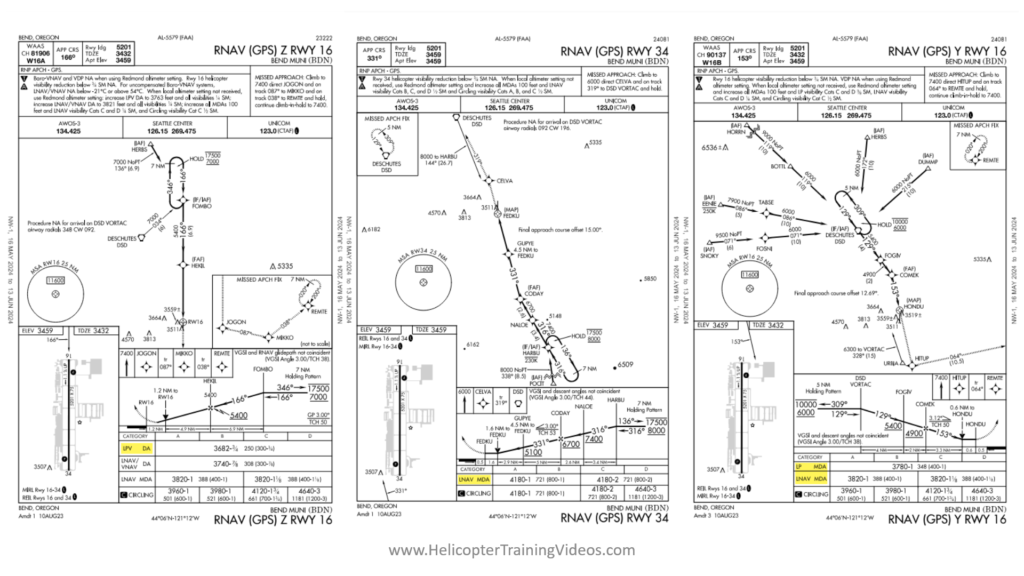
If a ground-based navigation approach is available, I think most evaluators will still want to see the applicant fly one, even if not required, to ensure they can fly an approach using the VOR MON system if needed.
DME Arc
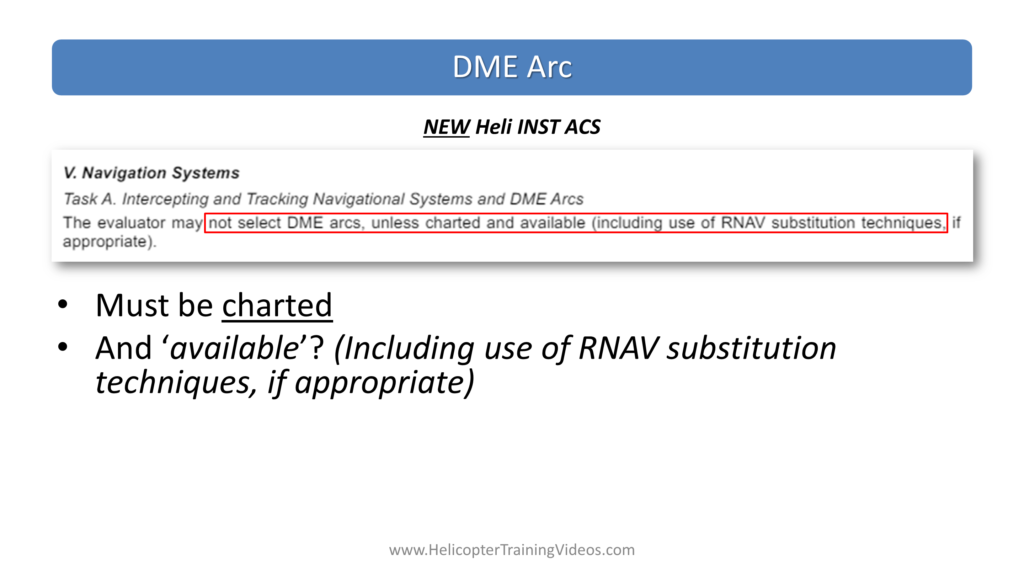
Appendix 3 of the Instrument ACS basically says that if a DME arc is unavailable, the evaluator will skip that task, rather than making up a non-published arc.
[UPDATE 07/12/2024] – The FAA Testing Standards Section (AFS-810) have stated to me in email that if the VOR is down, the arc will not be part of the checkride and the checkride can still be completed.
Attitude Instrument Flying
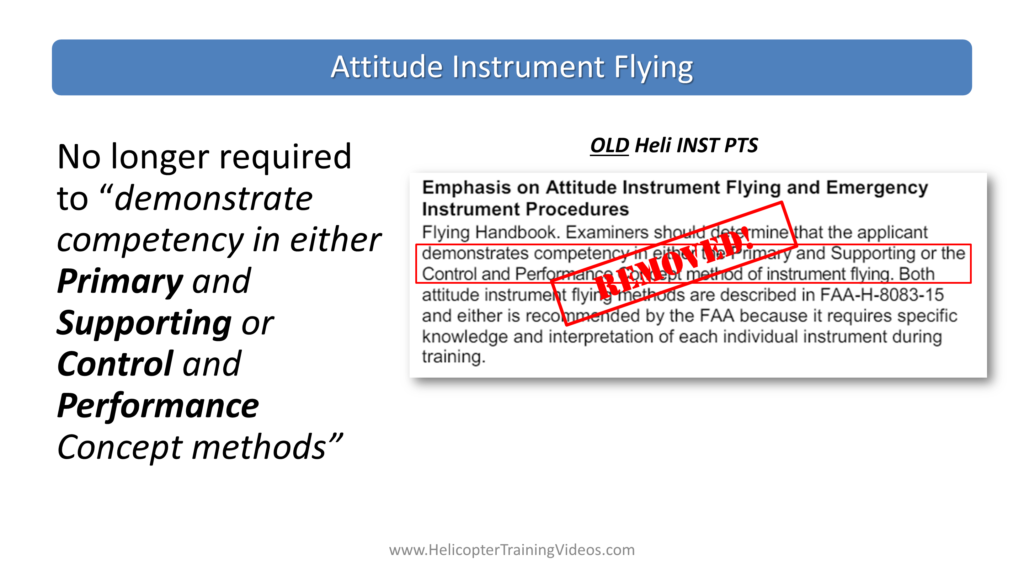
The old Instrument PTS said the applicant should demonstrate competency in either Primary and Supporting or Control and Performance Concept methods. That language is not longer in the ACS – so you can fly using whatever method you like as long as you meet the ACS standards. But the CFII PTS update did not change the requirement to teach one of these methods – so you might as well get to know at least one of those methods pretty well if you intend to teach one day.
Missed or VDP
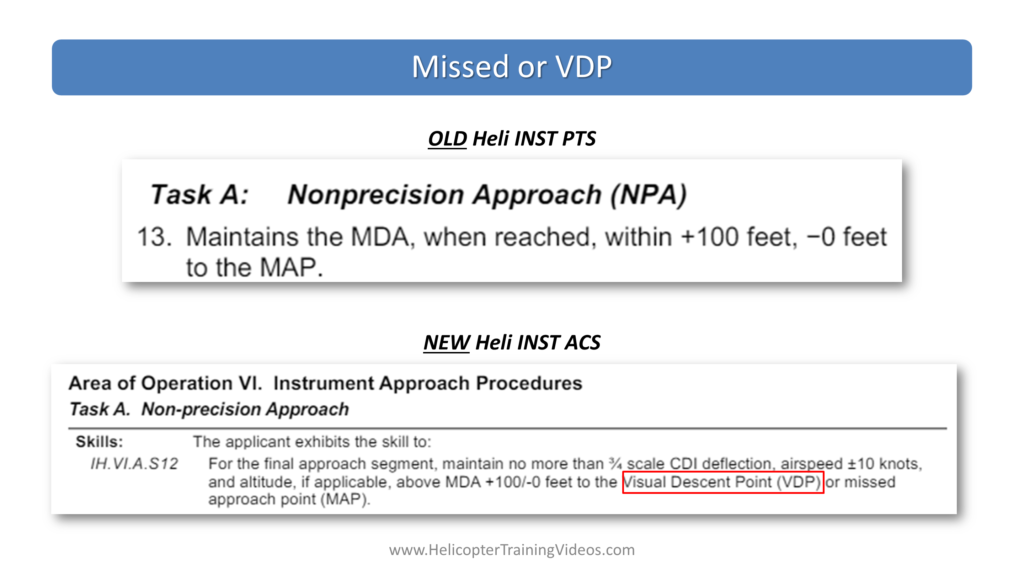
The old PTS required the applicant to be at Minimum Descent Altitude (MDA) +100/-0 feet by the Missed Approach Point (MAP). The new ACS allows applicants to be at MDA by the MAP or the Visual Descent Point (VDP). Obviously the evaluator and applicant have to agree which will be used prior to reaching the MAP/VDP to avoid the applicant descending to land or going missed too early.
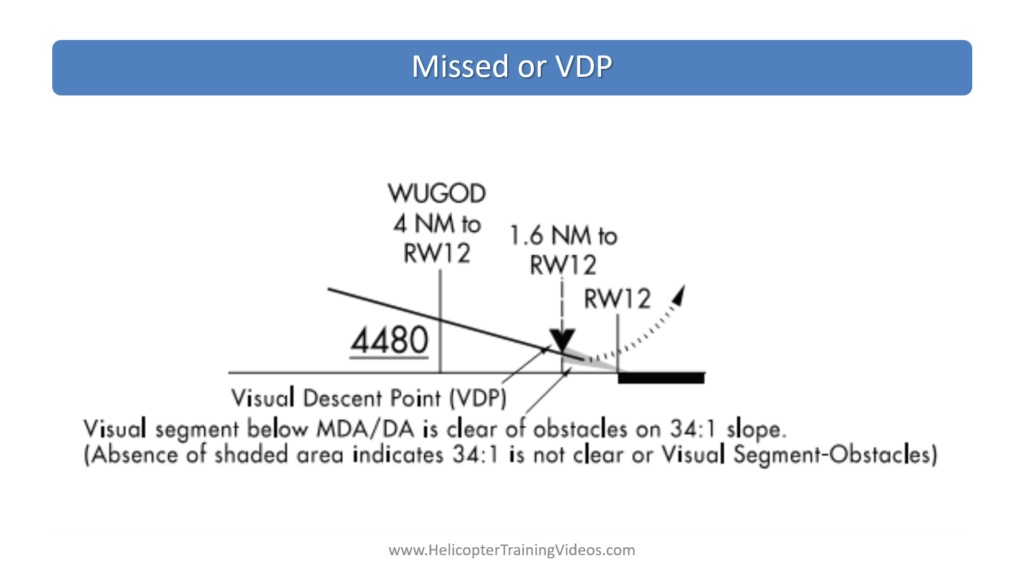
One technique I use in training is to be the ‘outside eyes’ for the student and I will announce one of the following at some point prior to the MAP/VDP as applicable:
- “I see approach lights” – if the approach has approach lights, the student should descend below the MDA to 100′ above touchdown zone (per 91.175).
- “I see the runway” – if the aircraft is in a position to land, the student can look up and start the descent.
- I stay silent – depending on what was agreed (VDP or MAP) the student will begin a missed approach when arriving at the VDP/MAP.
Judgement Assessment Matrix
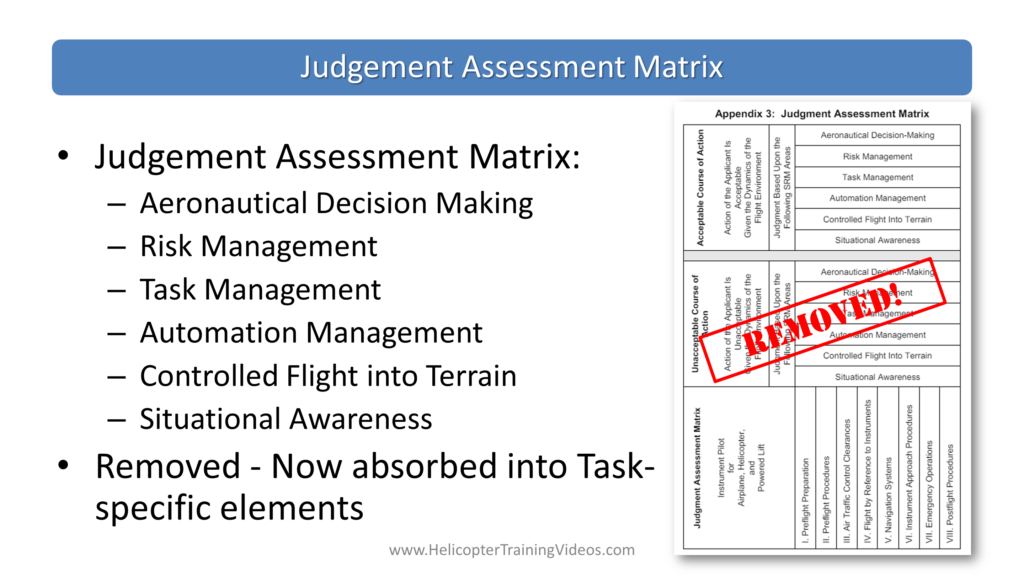
The old Instrument PTS had the Judgment Assessment Matrix, which had some good considerations to assess on a checkride, but has been removed in the new ACS. Instead those considerations have been incorporated into the risk management elements of the relevant tasks. The CFII PTS update also removed the Judgement Assessment Matrix, but there are no risk management elements of the PTS tasks to take its place.
SRM ‘Tasks’
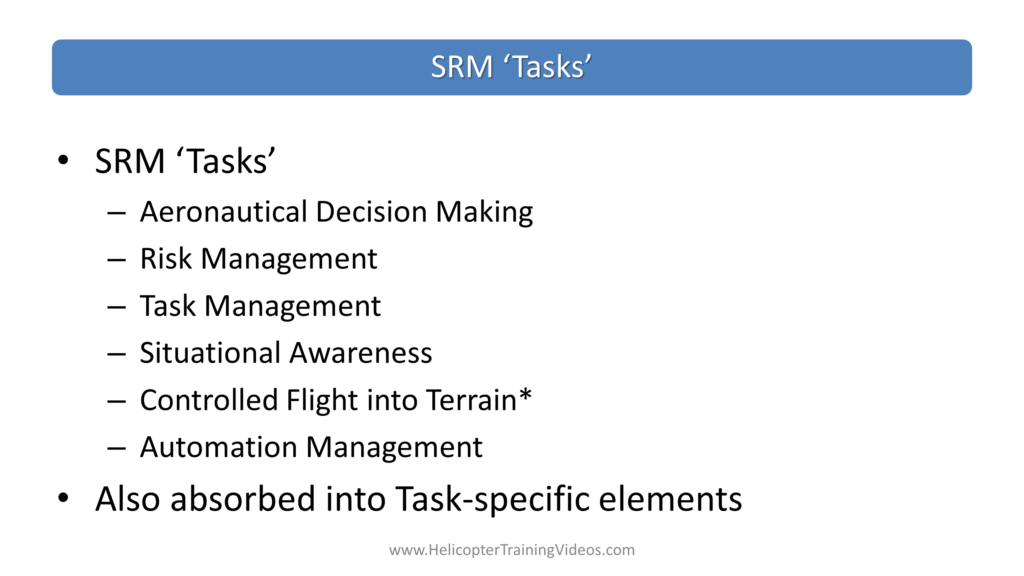
The old Instrument PTS also had six SRM task-like items that were also assessed in the checkride. Again, important areas of consideration and assessment. Just like the Judgement Assessment Matrix, this was removed in the ACS (and the CFII PTS) and those areas were incorporated into ACS task-specific risk management elements. Except “Controlled Flight into Terrain” (or “CFIT”) was not found anywhere in the new Instrument ACS.
New, Renamed & Reordered Tasks
A big part of the changes from PTS to ACS is the renaming, reordering, removing and adding of tasks. Compared to the other new ACS, the Instrument ACS hasn’t had too many changes to task titles, orders, etc. The following is summary of the changes for each area of operation (AOO). This is just the task name & order changes – full details of what elements actually changed within every task will require you to read every line the ACS, as you should for full preparation for a checkride!
I. Preflight Preparation Tasks
No changes to the task names or orders in the Preflight Preparation area of operation. But remember, that is just the task titles, the content of every task has new elements – you must read through the full ACS line by line.
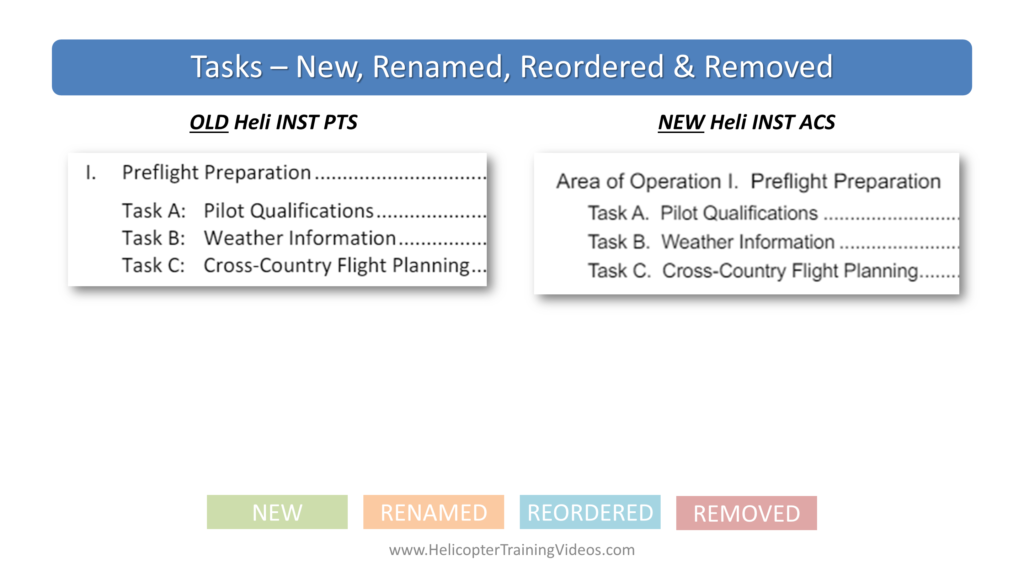
II. Preflight Procedures Tasks
Minor changes to the task names:
- Task B, Aircraft Flight Instruments and Navigation Equipment becomes Helicopter Flight Instruments and Navigation Equipment (but Task A, Aircraft Systems did not become Helicopter Systems)…
- Task C, Instrument Cockpit Check became Instrument Flight Deck Check – all the ACS changed “cockpit” to “flight deck”.
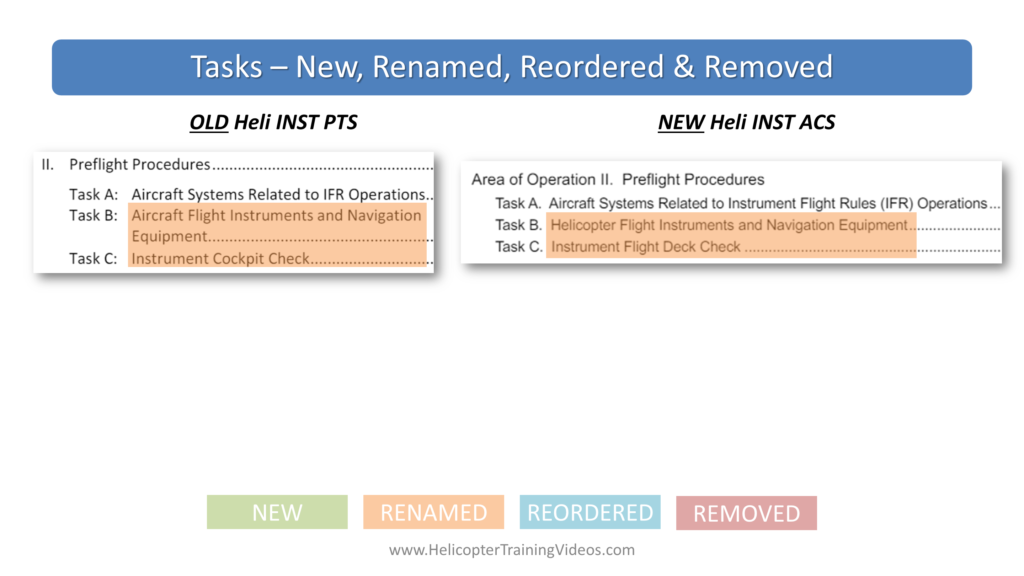
III. Air Traffic Control (ATC) Clearances & Procedures Tasks
Task A, became
Task B, Compliance with Departure, Enroute & Arrival Procedures and Clearances task was removed and most of the content was absorbed into other tasks, including the new Task A (Compliance with ATC Clearances) and the new Task B (Compliance with Departure, Enroute & Arrival Procedures) in Navigation Systems area of operation.
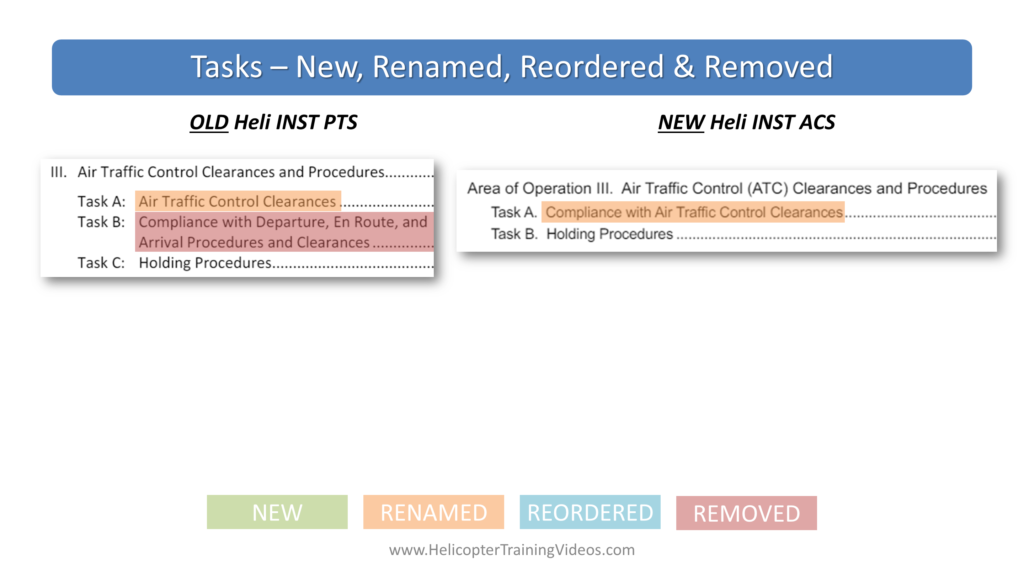
IV. Flight by Reference to Instruments Tasks
All the initialisms (IA, IH, PL, AA, HA, PLA & PC) have been removed from Task A and it just becomes Instrument Flight.
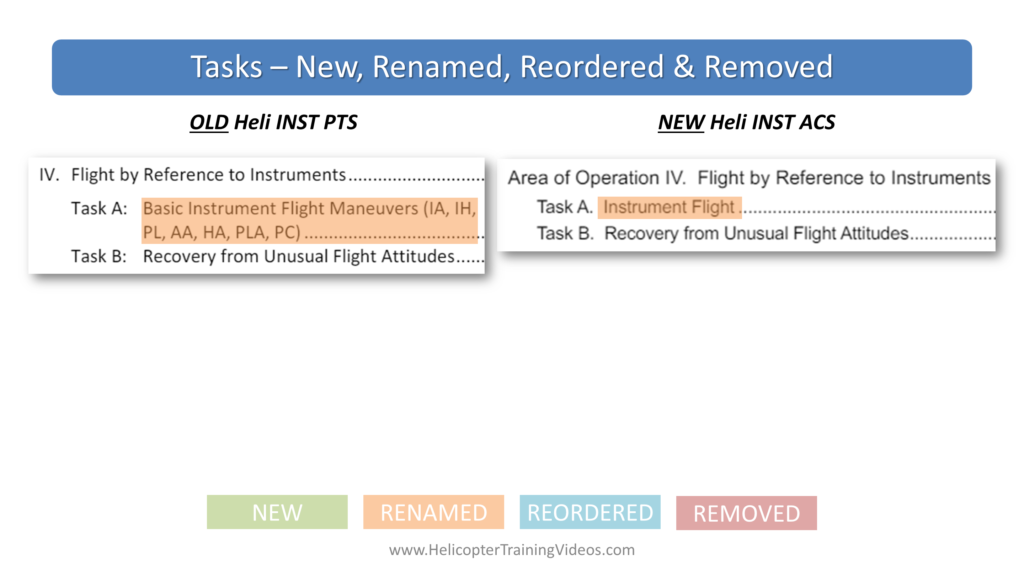
V. Navigation Systems Tasks
A new task was added (Departure, En-Route and Arrival Operations) moved from area of operation III (ATC Clearances and Procedures).
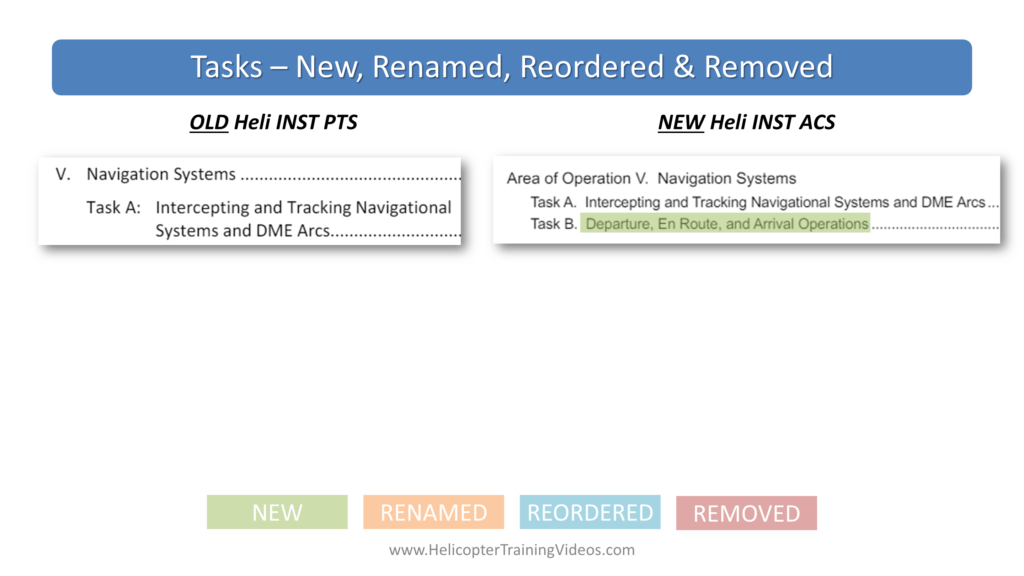
VI. Instrument Approach Procedures Tasks
Minor title changes (removed “NPA” and “PA” from Task A and B) as well as changing Landing from Straight-In Or Circling Approach to simply Landing from an Instrument Approach.
Circling Approach was removed because it was an airplane-only task (when the PTS was Airplane and Helicopter) as now the ACS is helicopter-specific.
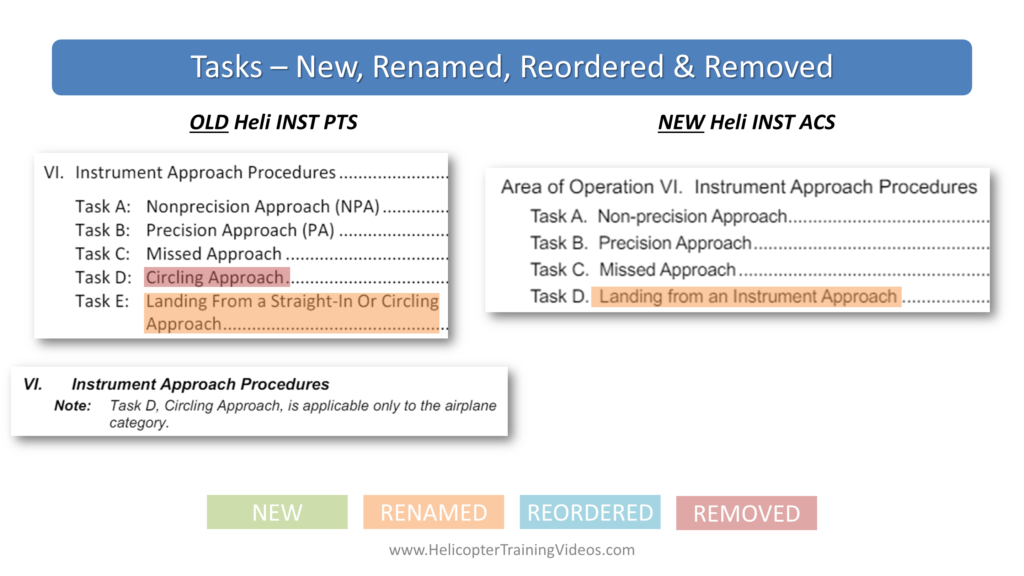
VII. Emergency Operations Tasks
Task B and C were removed because they were multi-engine airplane tasks and Instrument Approach and Landing with an Inoperative Engine (Simulated) was added for multi-engine helicopters.
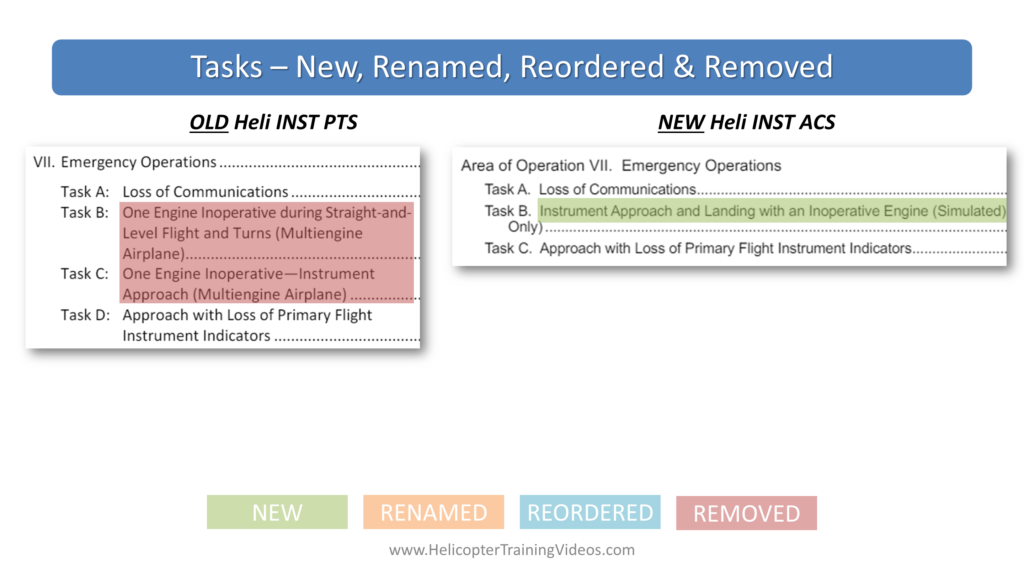
VIII. Postflight Procedures Tasks
No changes to the task names or orders, but remember, that is just the task titles, the content of every task has new elements – you must read through the full ACS line by line.
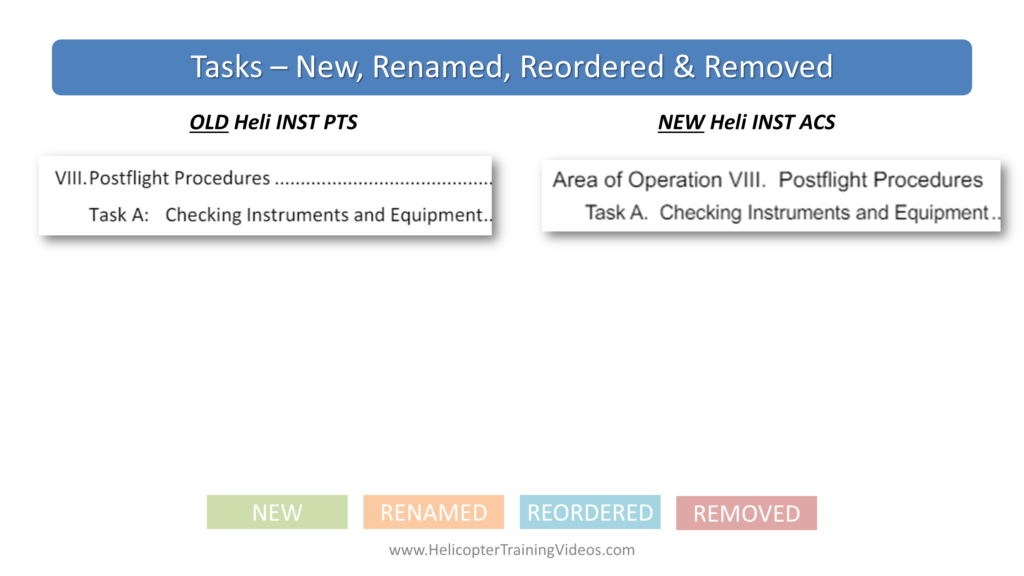
More Info
To learn more about the change from Helicopter PTS to ACS, check out the following:
- Helicopter ACS General Changes Video and article
- Helicopter ACS Playlist (Full Details for PVT, COM, INST & CFI Changes)
- FAA Airmen Certification Standards
- ACS Companion Guide for Pilots (Nov 2023)
- Short WINGS course on ACS
- LSR (PTS) Codes List
- ACS Tips for Evaluators (includes SBT ideas)
If you want to purchase the paper versions below are Amazon affiliate links that help support HTV. Paper versions also come with the ACS Companion Guide for Pilots (FAA-G-ACS-2).
DISCLAIMER – make sure you are fully informed on the latest regulations and their application.
For official guidance on laws and regulations, refer to your Certified Flight Instructor (CFI) or local Flight Standards District Office (FSDO) . Helicopter Training Videos aims to promote aviation knowledge and safety but makes no guarantees regarding accuracy or legal applications.
Feedback
What big changes to the Helicopter Instrument ACS have you seen? Let us know using the comments form below:




